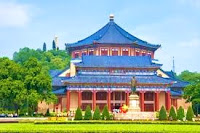THE PURPOSE OF RESEARCH IS
TO MAKE TWO QUESTIONS GROW WHERE ONLY ONE GREW BEFORE.
Yee
Ching Wong was born in the city of Guangzhou in the People’s Republic of China
on August 27, 1947. Her father was a local businessman and her mother a
homemaker. In 1952, when Yee was five, the family escaped Communism by fleeing
to British Hong Kong, seventy miles to the south.
She was enrolled in a
Catholic school there; and was a bright, capable student. Because of her
potential, the nuns of the school believed that Yee should have an English name
to enhance her opportunities. Her father, who didn’t speak English, turned to
the newspaper to select Yee’s new name. It seems that the week before a storm
came through Hong Kong that was named Typhoon Flossie. That was it! The young
girl’s new name would be Flossie. Later, she said, “I used to be embarrassed by
it. Now I’m trying to change the image of the name.”

Flossie
was an exceptional student and those around her encouraged her to study science
(an option that would not have been available in Communist China). She wasn’t
interested but followed their advice any way. The more she studied it, the more
she learned to love it. Graduating from high school in 1965, Flossie Wong was
sent to the U.S. to further her studies. Her family enthusiastically supported
her education. She enrolled at UCLA, majoring in molecular biology. In 1968,
she graduated Magna Cum Laude with a degree in bacteriology.
Flossie
did postgraduate work at UC San Diego until 1972. She married there; her next
new name being Flossie Wong-Staal (a name she kept even after a later divorce).
The next year, she moved to the east coast, taking a position with the National
Cancer Institute in Maryland. Her work focused on retroviruses - a mysterious
group of viruses of which little was known.
By 1980, the AIDS epidemic
was first recognized. Researchers at the National Cancer Institute lab were working
to isolate the cause of AIDS and the many illnesses that make up the syndrome.
Dr. Flossie Wong-Staal worked with the noted researcher Robert Gallo. Together
they first identified the HIV virus and its link to AIDS in 1983. Flossie is
credited with the first cloning of the HIV virus and the first genetic mapping
of it. Her monumental breakthrough allowed the development of diagnostic tests
to screen patients and donated blood supplies for the HIV virus.

In
1990, the Institute for Scientific Information named Flossie Wong-Staal as the
top woman scientist of the 1980’s, as well as the fourth-ranked scientist in
the world under the age of 45. That same year she returned to the University of
California at San Diego. Four years later, Flossie was named to direct the new Center
for AIDS Research, at UC San Diego, where she and her staff worked to find a
vaccine for the HIV virus, and a cure for AIDS, using the techniques of gene
therapy. After several years in this position, Flossie left to co-found iTherX Pharmaceuticals,
a company focusing on treatments for Hepatitis C. She is its Chief Scientific
Officer. She still holds the title of Professor Emeritus at the University of
California.

Today
she is acknowledged as one of the world’s foremost authorities on viruses, and
HIV specifically. In 2002, Discover Magazine named Flossie Wong-Staal as one of
the fifty most extraordinary women scientists in the world. She was also
elected to the Institute of Medicine of the U.S. National Academies. Then in
2007, The UK’s Daily Telegraph listed her as #32 on its list of the “Top 100
Living Geniuses.”
Not a bad record for the
little Chinese-American girl who didn’t like science.





No comments:
Post a Comment